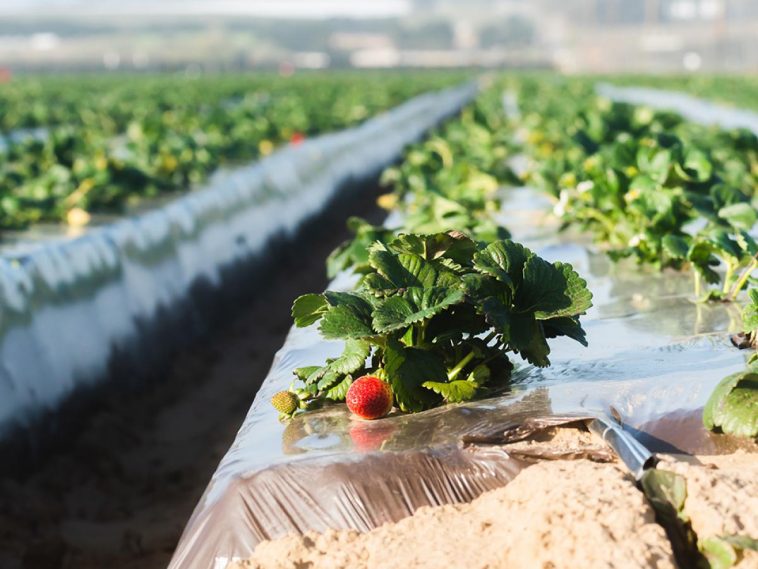One of the key challenges that plastic use in agriculture presents is the process of its disposal. Plastic does not break down naturally, therefore if not handled properly, it can pollute natural systems, such as the soil, plants, rivers and oceans, all of which play a role in various agricultural production systems.
The optimisation of the use of plastic on the farm is not easy to implement in many situations due a myriad of factors such as the lack of time, difficulty to invest in a good equipment, lack of information, and other priorities on the farm. However, despite these setbacks, for agriculture to thrive and for the existence of a balance between plastic use and its effects, opportunities that may be provided by the reduction, recycling and reuse of plastic cannot be overlooked.
The reduction of plastic use on the farm can be done by minimising or avoiding the packaging of the inputs of the farm. For example, farmers can use bulk fetrilizer instead of fertiliser in bags. Another method that can work is by using an agricultural technique that does not use plastic or reduce its use in the process of production.

Source: Pixabay
According to the document, Reducing the plastic footprint of agriculture (2021), reuse of plastic on the farm if used correctly, without damage, can be employed in the use of tarpaulins. These can be reused from one year to the next. Sometimes plastic products cannot be used again after the first use for the same function, but can be used for other purposes on the farm. For example, in Poland, film from covering silage for dairy cows is very often reused as protection in grain handling and storing.
The recycling of plastic can be done though six steps. First, the discarded plastic must be neat, dry, clean and as compacted as possible. It is best stored in a dry corner of a barn or outdoors on a pellet off the ground. It is advisable to keep grit and dirt off it. Air within the plastic can be removed by placing a weight on top.
The second step is in finding an ideal location. The area is best centrally located from where the plastic is collected and spacious enough to store the material collected and equipment. It should also allow for the easy movement of transport and people. Thirdly, to attract recycling companies. In the cases where the agribusiness is small, it is advisable to recruit other farmers so as to increase the quantity of plastic to be collected.
In some cases, farmers bring their plastics to a central location.
Plastic buyers would have to be identified right from the start of the programme to allow contributors to be aware of the requirements to meet for the plastic to be delivered.
Lastly, the plastic collectors may be able to access recycling subsidies. Agencies or municipalities interested in conserving landfill space or reducing pollution may be able to offset costs of the programme incurred by training, transportation, compaction, et cetera.

Source: Pixabay
When it comes to the reuse of plastic, some plastic can be cut or physically altered for other uses. According to Clarke (1996), plastic film (wrap) can be used in pillows. Current materials for pillows include straw and ground-up rubber tires. Also, feed bags can be reused two to three times if they are in good condition.
Plastic agricultural grade film from bags, tubes and sheets can be reused for covering piles of wood and hay, machinery, and for protective liners for horizontal silos. The number of times the plastic can be reused will depend on the severity of tears and holes in the plastic.
An alternative that agribusinesses could look at is the use of biodegradable plastic. An area of use for biodegradable plastic is for example in mulching. According to Agriplasticscommunity.com it is an option that could be sustainable because it is less invasive, greener and helps to significantly reduce the quantity of agricultural waste. However, farmers should keep some factors in mind, such as regulations that allow the use of biodegradable mulching.
The proper use of plastic can be spurred by the collaborative participation of policymakers, environmentalists, researchers, industries and farmers’ organisations. These participants have to work together to find a good balance between economic interests and environmental challenges.
References
Thibodeaux, J. Recycling agricultural plastic is growing industry. (2015) Available at: https://greensourcedfw.org/articles/recyclingagricultural-plastic-growing-industry
James, B., Trovati, G., Peñalva, C., Czech, L., Mendioroz, I., Miličić, V. EIP-AGRI Focus Group. (2021) Reducing the plastic footprint of agriculture. Available at: https://ec.europa.eu/eip/agriculture/sites/default/files/eip-agri_fg_plastic_footprint_minipaper_d_final.pdf
Minimising Plastic Waste on Farm – Reduce, Reuse & Recycle. (2019) TECHNICAL NOTE TN724. ELEC. Available at: https://www.fas.scot/downloads/tn724-minimising-plastic-waste-on-farms/
Clarke, S. (1996) Recycling Farm Plastic Films. Available at: http://omafra.gov.on.ca/english/engineer/facts/95-019.htm
Polycarbonate. (2022) Available at: https://www.bpf.co.uk/plastipedia/polymers/Polycarbonate.aspx









